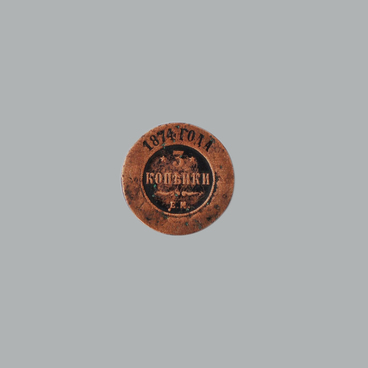This solid copper two-kopek coin, held in the Karasuksky Regional Museum’s collection, has a peculiarity - the design on both sides is positioned lower down. Because of this, the dotted rim is not visible on the obverse or the reverse of the coin.
On the obverse of this two-kopek coin, minted in Suzun, is a two-headed eagle with three crowns, an orb and a scepter. There is a shield on the eagle’s chest, whilst the year of issuance, 1810, is embossed in a semicircle around the eagle. The letters on the coin’s reverse have almost completely worn off, but it is still possible to distinguish that the inscription reads ‘2 Kopeks’. Under the coin’s value, the letters ‘KM’ are written, referring to Kolyvan copper, which is a special type of copper containing residues of gold and silver. A crown is depicted above the number.
Between 1810 and 1830, copper coins were minted at the mints in Yekaterinburg (with the designation EM), Saint Petersburg (with the designation SPB) and Suzun (with the designation KM). Money minted at the Izhorsk or Kolpinsk mints were stamped with the designation ‘IM’, whilst the two-kopek coins from 1810 had the stamp: KM-MK. Coins were produced in 24 ruble ratios, that is to say that 16.3 kilograms of copper was turned into 24 rubles of one type of coin, for example, two-kopeks.
According to Vladimir Bitkin’s catalog, this coin is considered to be relatively common. 250,000 rubles of this coin were in circulation, but information regarding this volume in 1810 includes coins produced in 16 ruble production runs as well as 24 ruble production runs, which were minted at the Suzun mint between 1810 and 1812. This two-kopek coin weighs in at 12.65 grams. The rim or edge of the coin is smooth, without any markings. Markings on coin edges appeared at the beginning of the 16th century in order to protect the coins from becoming filed down or breaking apart. Today, it is often possible to determine the authenticity of a coin by looking at its edge. It is almost impossible to forge a coin’s edge.
A chain of the Order of Saint Andrew is depicted around the shield on the coat of arms. This is the only Russian order to have a chain. The order, which is covered by multicolored enamels, gold and ornaments, is only worn for state occasions. According to different sources, since the order was created, it has been awarded to between 900 and 1100 people.
Another peculiarity of the order on this two-kopek coin is the type of eagle. It is not similar to the usual depiction of the Russian State eagle: its heads, which are both upturned dramatically, and its rich plumage look more like a black grouse. As Siberia was relatively far away from the capital, the local stamp makers’ interpretation of the emblematic eagle remained on coins minted in Siberia for a rather long time - until 1812.
On the obverse of this two-kopek coin, minted in Suzun, is a two-headed eagle with three crowns, an orb and a scepter. There is a shield on the eagle’s chest, whilst the year of issuance, 1810, is embossed in a semicircle around the eagle. The letters on the coin’s reverse have almost completely worn off, but it is still possible to distinguish that the inscription reads ‘2 Kopeks’. Under the coin’s value, the letters ‘KM’ are written, referring to Kolyvan copper, which is a special type of copper containing residues of gold and silver. A crown is depicted above the number.
Between 1810 and 1830, copper coins were minted at the mints in Yekaterinburg (with the designation EM), Saint Petersburg (with the designation SPB) and Suzun (with the designation KM). Money minted at the Izhorsk or Kolpinsk mints were stamped with the designation ‘IM’, whilst the two-kopek coins from 1810 had the stamp: KM-MK. Coins were produced in 24 ruble ratios, that is to say that 16.3 kilograms of copper was turned into 24 rubles of one type of coin, for example, two-kopeks.
According to Vladimir Bitkin’s catalog, this coin is considered to be relatively common. 250,000 rubles of this coin were in circulation, but information regarding this volume in 1810 includes coins produced in 16 ruble production runs as well as 24 ruble production runs, which were minted at the Suzun mint between 1810 and 1812. This two-kopek coin weighs in at 12.65 grams. The rim or edge of the coin is smooth, without any markings. Markings on coin edges appeared at the beginning of the 16th century in order to protect the coins from becoming filed down or breaking apart. Today, it is often possible to determine the authenticity of a coin by looking at its edge. It is almost impossible to forge a coin’s edge.
A chain of the Order of Saint Andrew is depicted around the shield on the coat of arms. This is the only Russian order to have a chain. The order, which is covered by multicolored enamels, gold and ornaments, is only worn for state occasions. According to different sources, since the order was created, it has been awarded to between 900 and 1100 people.
Another peculiarity of the order on this two-kopek coin is the type of eagle. It is not similar to the usual depiction of the Russian State eagle: its heads, which are both upturned dramatically, and its rich plumage look more like a black grouse. As Siberia was relatively far away from the capital, the local stamp makers’ interpretation of the emblematic eagle remained on coins minted in Siberia for a rather long time - until 1812.



